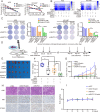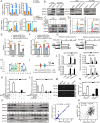HNF4A-BAP31-VDAC1 axis synchronously regulates cell proliferation and ferroptosis in gastric cancer
- PMID: 37296105
- PMCID: PMC10256786
- DOI: 10.1038/s41419-023-05868-z
HNF4A-BAP31-VDAC1 axis synchronously regulates cell proliferation and ferroptosis in gastric cancer
Abstract
B cell receptor associated protein 31 (BAP31) is closely associated with tumor progression, while the role and mechanism of BAP31 in gastric cancer (GC) remains unknown. This study explored that BAP31 was upregulated in GC tissues and high expression indicated poor survival of GC patients. BAP31 knockdown inhibited cell growth and induced G1/S arrest. Moreover, BAP31 attenuation increased the lipid peroxidation level of the membrane and facilitated cellular ferroptosis. Mechanistically, BAP31 regulated cell proliferation and ferroptosis by directly binding to VDAC1 and affected VDAC1 oligomerization and polyubiquitination. HNF4A was bound to BAP31 at the promoter and increased its transcription. Furthermore, knockdown of BAP31 inclined to make GC cells vulnerable to 5-FU and ferroptosis inducer, erastin, in vivo and in vitro. Our work suggests that BAP31 may serve as prognostic factor for gastric cancer and act as potential therapeutic strategy for gastric cancer.
© 2023. The Author(s).
Conflict of interest statement
The authors declare no competing interests.
Figures








Similar articles
-
The lncRNA BDNF-AS/WDR5/FBXW7 axis mediates ferroptosis in gastric cancer peritoneal metastasis by regulating VDAC3 ubiquitination.Int J Biol Sci. 2022 Jan 24;18(4):1415-1433. doi: 10.7150/ijbs.69454. eCollection 2022. Int J Biol Sci. 2022. PMID: 35280682 Free PMC article.
-
HNF4A promotes tumor progression in gastric cancer by transcriptional activation of KIF2C.Clin Exp Med. 2025 Jun 14;25(1):205. doi: 10.1007/s10238-025-01748-2. Clin Exp Med. 2025. PMID: 40517212 Free PMC article.
-
Long noncoding RNA ZEB1-AS1 attenuates ferroptosis of gastric cancer cells through modulating miR-429/BGN axis.J Biochem Mol Toxicol. 2023 Aug;37(8):e23381. doi: 10.1002/jbt.23381. Epub 2023 May 2. J Biochem Mol Toxicol. 2023. PMID: 37128782
-
Biological roles of the B cell receptor-associated protein 31: Functional Implication in Cancer.Mol Biol Rep. 2021 Jan;48(1):773-786. doi: 10.1007/s11033-020-06123-w. Epub 2021 Jan 13. Mol Biol Rep. 2021. PMID: 33439410 Review.
-
Ferroptosis: opening up potential targets for gastric cancer treatment.Mol Cell Biochem. 2024 Nov;479(11):2863-2874. doi: 10.1007/s11010-023-04886-x. Epub 2023 Dec 11. Mol Cell Biochem. 2024. PMID: 38082184 Review.
Cited by
-
Infection of Helicobacter pylori contributes to the progression of gastric cancer through ferroptosis.Cell Death Discov. 2024 Dec 2;10(1):485. doi: 10.1038/s41420-024-02253-3. Cell Death Discov. 2024. PMID: 39622791 Free PMC article. Review.
-
Hepatocyte nuclear factor 4-Alpha: a key regulator in liver carcinogenesis.Cell Oncol (Dordr). 2025 Aug;48(4):885-897. doi: 10.1007/s13402-025-01064-7. Epub 2025 May 20. Cell Oncol (Dordr). 2025. PMID: 40392499 Free PMC article. Review.
-
CircVPS8 promotes the malignant phenotype and inhibits ferroptosis of glioma stem cells by acting as a scaffold for MKRN1, SOX15 and HNF4A.Oncogene. 2024 Aug;43(36):2679-2695. doi: 10.1038/s41388-024-03116-y. Epub 2024 Aug 4. Oncogene. 2024. PMID: 39098847
-
The role of epigenetic regulation in cuproptosis, ferroptosis and NETosis in the pathogenesis of autoimmune diseases.Apoptosis. 2025 Aug 21. doi: 10.1007/s10495-025-02158-1. Online ahead of print. Apoptosis. 2025. PMID: 40839326 Review.
-
The metabolites of gut microbiota: their role in ferroptosis in inflammatory bowel disease.Eur J Med Res. 2025 Apr 7;30(1):248. doi: 10.1186/s40001-025-02524-4. Eur J Med Res. 2025. PMID: 40189555 Free PMC article. Review.
References
Publication types
MeSH terms
Substances
LinkOut - more resources
Full Text Sources
Medical
Miscellaneous

